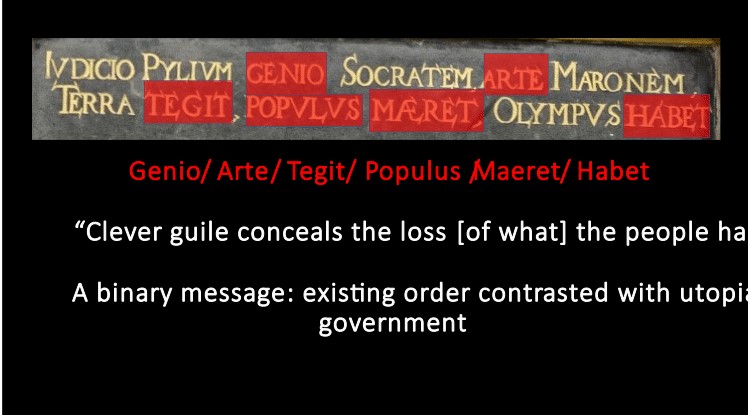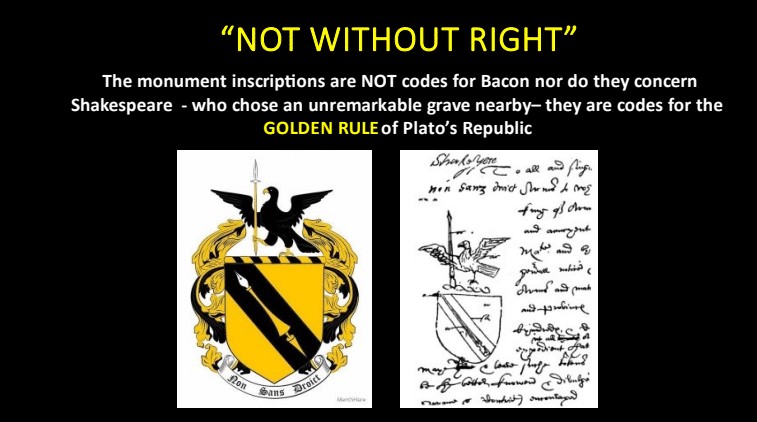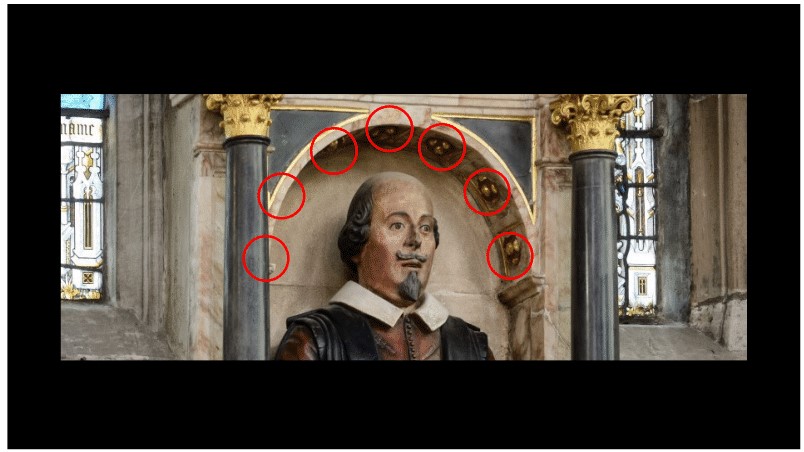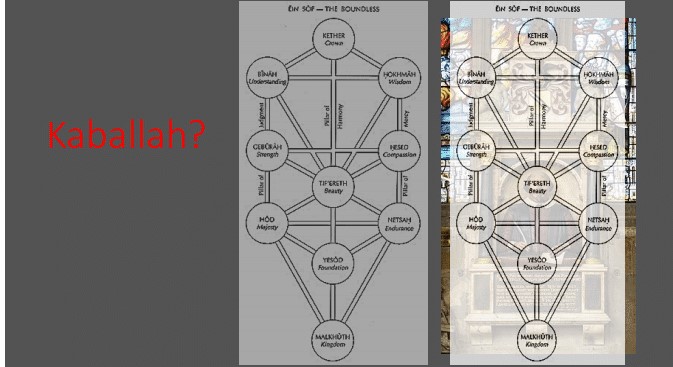Research Paper Presented to the Metropolitan Study Group on 18th March 2023
by M.R. Osborne, CCR
My paper concerns the hidden symbolism in the funerary monument of William Shakespeare located at Holy Trinity Church in Stratford-upon-Avon, Warwickshire. Shakespeare died aged 52 on 23 April 1616. A cantilevered monument–shown here–was erected close to his grave shortly afterwards. We know it was already in place by the time the First Folio of his plays was published in 1623, as the prologue by his friend Leonard Digges refers to it. An interesting aside is that Digges father, Thomas, was raised by Dr John Dee, and became the court mathematician and astronomer to Elizabeth I.

Various sketches and engravings were made of the memorial prior to its restoration in 1749.The first engraving was by William Dugdale in in 1634, pictured here. Wenceslaus Hollar based his engraving on Dugdale's sketch in 1656,but does at least include an allusion to the epitaph. George Vertue's engraving of 1723 shown here pre-dates the 1749 restoration of the monument––and is the most accurate presentation of the original prior to its restoration. In this engraving the cushion, page and quill are shown, whereas they are absent in the Dugdale and Hollar versions, which also show a woolsack not a cushion. This difference is cited by Anti-Stratfordian apologists to argue that Shakespeare was a patsy for Bacon and more vested in farming than writing plays. However, it is unlikely there was any work carried out on the monument in the 100 years following Shakespeare's death and the earlier pictures lack symmetry and contain numerous inconstancies. So the memorial likely appears today much the same as when it was first erected.

The monument is a typical cantilevered structure, made from an array of materials. Here are examples of others from the period and you can see the similarities. Shakespeare's monument was less expensive and refined than many. The limestone figure was originally painted, whitewashed in the C18th and repainted. He holds a quill, and a blank page resting on a cushion. The playwright's three “working tools.” There are two Corinthian columns made of polished black marble, and the inlaid panels are black touchstone. The capitals, bases and skull are in carved sandstone, as are the two putto or cherubim, which symbolise Adam's labour (one holds a trowel), and his rest in death-represented by the inverted torch and skull. The architraves, frieze and cornice were the only parts of the structure replaced in 1749. Originally, they were red-veined alabaster but replaced with white marble presumably because it was more hard-wearing. We do not know who erected the monument. It could have been Digges, Jonson and any number of his other friends and admirers. Or it may have been his widow and family. Perhaps his patron Lady Anne Clifford? Regardless of who erected it, his family must have approved it. His widow Anne Hathaway died in1623, and one of his daughters, Suzannah, still resided in Stratford.

The entablature is comprised of the cornice, frieze, and architrave. As I have mentioned, these were replaced in 1749.The columns are comprised of the sandstone capital, marble shaft and sandstone base and pedestal. Three cornices assist with the cantilevering of the monument to the wall, and behind it are iron hooks. It is odd that there are 3 cornices, however, as 2 would have sufficed. They add an interesting symmetry to the design which we will consider later. The inlaid panels area black touchstone and may have been added later if Dugdale's sketch is in any way accurate (although it may not be). The limestone figure is noted for its blank expression and in that sense is more atypical of the time. It has however been whitewashed and repainted since its original installation. Moulded into the arch are 7 red roses. There is above the entablature a triadic assemblage of the putti and a crowning skull, with the poet's coat of arms fixed in the centre.

An interesting and unusual aspect of the floor plan of Holy Trinity Church is that the transepts, chancel and quire were designed to point north-east, and not in the direction of the West-East axis we would expect. The transepts date from the C13th, and then someone corrected the alignment with the nave and aisles in the C14th. The construction of the chancel in the late C15th deliberately continued the North-East alignment. Chantry was established at this time. This was probably quartered in one of the rooms of the now-demolished charnel house built against the north wall. Here prayers for the repose of the dead in Purgatory were recited literally in the presence of the earthly remains removed there. The Chantry was established by Dean Bramhall who is buried a couple of feet from Shakespeare's grave. The monument to Shakespeare is here, next to Bramhall's tomb and is fixed in the northeast corner of the chancel due to the direction of the church. The chantry was disestablished between 1545-1547 following the two Abolition of Chantries Acts. The charnel houseconsistedof3floorsincluding the basement. A door in the chancel, now bricked over, provided access to the upper floors of the building. It is possible that the upper floor was once used for services to dedicate the bones held in the subterranean chamber or crypt beneath, but it is certain that the upper room was used as a sacristy. The structure was demolished in 1800.

A closer look at the Chancel. Here are some of the key fixtures. Shakespeare's monument is presented directly in line with the NE direction drawn from the centre of the Chancel. This then progresses through the old charnel house which may have held the Chantry established by Dean Bramhall. Anne Hathaway died in 1623 and rests between the grave of her husband and his monument. There is then her son-in-law, Dr John Hall; Thomas Nash, first husband of her granddaughter, Elizabeth daughter Susannah.

It is unlikely Shakespeare ever thought his bones would be disturbed by the ordinary re-use of his grave space and reinterment of bones in a charnel house because he was entitled to be buried in the chancel as a lay rector and wealthy local landowner. It does suggest, however, that he was concerned his remains may be disturbed by relic hunters.

The chancel area is shown here, with grave, memorial, door to Charnel house and approximate site of the Charbel house building beyond the north wall. Archaeologists surveyed the site with ground-penetrating radar in 2014 and determined that Shakespeare's grave had indeed been disturbed. They believe his skull is missing. Indeed, there is a local legend of his grave being disturbed in the 1780s by relic hunters who removed the skull. Allegedly fearing the curse and unable to find a purchaser, they tried to reinter it and, unable to, placed it in the crypt of another Church instead. The place where Shakespeare's grave is likely to have been disturbed is shown in this 2014 radar image, where the repaired gravestone is supported by a brick structure. Interestingly the skull purported to be Shakespeare's at Beoley Church was in fact determined to be that of a woman in her 70s, again reflecting the written testimony of one of the grave robbers that the skull they unearthed at shallow depth was “dainty and small, not like a man's.” One theory is that it may in fact be Anne Hathaway's, who switched out her grave with that of her husband to protect it from disturbance. Indeed, her official grave lies immediately beneath the monument.

The carved sandstone skull is typical of Jacobean period memorials. The contrast between life and death was often made, with images of the deceased contrasted with images of their bones. This was common for the period The skull is in direct correspondence with the figure of the living Shakespeare, which connects neatly with the two putti representing labour and rests in the form of death on either side of it. These symbols intentionally create a cross, the enduring symbol of humanity's rest from Adam's curse through the promise of eternal life beyond the grave.

The two putti shown form the base of a triadic shape, labour with the trowel on the left and death with an inverted torch on the right. The skull crowns the edifice and represents transition. The poet's coat of arms is centred in the middle. The entire image isa symbol of Judgement, Mercy, and Balance.

In the centre of the upper part of the monument is Shakespeare's Coat of Arms. Shakespeare invested considerable time and money obtaining these arms, and it remains unclear why he was so keen to do this given the untimely death of his only son Hamnet in1596. A clue lies in its symbolism which, like the monument itself, conceals much more than first appears. There is no surviving record of how the arms were actually coloured except in the written grant because the memorial was painted over twice: “Gold, on a bend, sable, a spear of the first, steeled argent; and for the crest a falcon his wings displayed argent, standing on a wreath of his colours supporting a spear gold, steeled as aforesaid, set upon a helmet with mantles and tassels. “The heraldic motto NONS SANS DROICT translates as NOT WITHOUT RIGHT. Aside from the obvious point that the spear references the family name, the spear conveys a double meaning. The first is the Catholic mystery of the Sacred Heart symbolised by the Spear of Destiny or of Longinus (which pierced Christ's heart to draw water and blood from his body (itself a metaphor for the dual nature of Christ).The second is that the spear or a long, sharp pointed trowel was originally used in the masonic guilds instead of a sword to guard the entrances of their lodges. The colours of black, gold and silver are also alchemical. Gold recalls “the Golden Ones” of Plato's Republic, who were the Philosopher Class ideally suited to govern a just and harmonious society based on the rule of reason and education. The colour gold also reminds us of the assaying of impurities in the fires of the metallurgists to extract the metal. The black is that of the earth from which gold is drawn and the silver in the tip represents mercury, which has the power to extract gold from rough ore. The motifs and colours in the coat of arms cannot be anything other than a statement of Shakespeare's Rosicrucian ideals. There are simply too many coincidences.

The Latin epitaph carved on the black touchstone reads Most of the symbolism contained in the monument relates to the number 3 or its divisions of it. It is carefully constructed and rich in meaning. The poem in English is interpreted by reference to the Latin text, and whose meaning is cleverly concealed in text regarded as mundane by scholars or obscure at best. Below this is an inscription bearing the date of Shakespeare's death and his incorrect age – he was 52, not 53 when he died. So again, it is about the choice of numbers. The numbers in both lines add up to 27, which divided by 3 becomes 9 (and 3 by reduction). Again, a triadic message and a clue to understanding the critical Latin epitaph.

The formulas contained in the Latin verse are unmistakable. The first reference to JUDICIO PYLIUM is to that of Nestor, the King of Pylos. Nestor is a character in the Iliad, noted for his wisdom and ingenuity. Called “the old war horse” by Agamemnon, Nestor provides more ships for the war than any other Greek king, brokers peace with Achilles and invents a signalling system for the Greek ships that avoid total defeat. In the Odyssey, we are told by Homer that Nestor was a good horseman and pious. He was a man of the world who understood the wisdom of the world and the way it works. Although the grandson of Poseidon, he was nonetheless a mortal. The genius of Socrates is referenced here as GENIO SOCRATEM. Socrates was famous for the formulation of a style of debating that used cross-examination and scrutiny. It was a method of discourse intended to avoid rashness and illogical conclusions or hasty judgments. His questioning method developed the ability to consider multiple perspectives. Socrates also had a political agenda and in promoting meritocracy questioned the Athenian constitution. He argued for Government by a philosophical class of men schooled in the art of the Socratic Method of reasoning.
ARTE MARONEM is a reference to Virgil, writer of the Aenid and “sequel” to the Iliad and Odyssey–and the three classics are often regarded as something of a “trilogy”. In the Aenid the Trojan prince Aeneas enters the afterlife as a living man to discourse with his thwarted lover Queen Dido of Carthage. Like Odysseus and Hercules, he was one of the few mortals to enter Hades and return to the world of the living. This was a plot device later used by Dante to resurrect Virgil as his guide through the 3realms of Hell, Purgatory and Heaven. Aeneas goes on to establish Rome, the New Troy. The art of Virgil therefore most probably alludes not to the leadership skills of his literary creation, Aeneas. Virgil himself was regarded as semi-divine by the Romans and attained immortality on account of his being the son of Venus adopted by Jupiter when he was renamed Jupiter-Indiges.
Beneath these three luminaries, the Latin text refers to states of being buried in the earth; the plight of humanity; and eternal life. We thus have Earth, Blood and Spirit-the black, red, and white correspond with the preceding three archetypes as “Golden Ones”-the first four colour terms of alchemy–and the primary terms embracing the alchemical opus describing the tripartite structure of the stages of the work; the condition of the materials worked on; and the altered state of the Artifex.

This repeated three-fold symbology is also to be found in other correspondences. An example of this is the way the words are lined up to form not only two horizontal sentences, but also three columns, which slightly changes–in the sense of clarifying-their meaning. Thus, we have THE EARTH BURIES A PYLIAN IN JUDGEMENT-the theme of the wise man entombed as a reflection of mortality and the curse of Adam in the form of death. The parting of the physical aspect of man from his mind or soul. The inference here may be to the legendary burial chamber of Christian Rosenkreutz, whose tomb recalled the words VISTA INTERIOR'A TERRAERECTI I'CANDO INVEN'IES OCCULTUM LAPIDEM–VISIT THE INTERIOR PARTS OFTHE EARTH; BY RECTI ICATION THOU SHALT IND THE HIDDEN STONE. “Here we have THE PEOPLE MOURNA SOCRATES IN GENIUS. Socrates' death marked the failure of the Greek state to co-exist with genius and free thought. Plato's Republic debates what justice is and explores the injustice of the rigid Greek view of citizenship by toleration of free thought, creativity, and progress. Plato's republic was not a democracy but a meritocracy, the ruling elite were “the Golden Ones” or a philosopher class. The idea was that science and education would eliminate poverty and violence. This was to be the product ofa50-yearprogrammecreating an elite group of philosopher kings who would re-organise the world. OLYMPUS POSSESSES A MARO IN ART. Olympus is a metaphor for Plato's republic, Utopia. The attributes of genius work through wisdom to create the result, which is Utopia (Olympus). Each archetype and corresponding state represents wisdom, truth and beauty.

The passer-by (the passenger)is intended to loiter in order to decipher the subtle symbolism contained in the monument. This is something most esoterically minded Elizabethans and Jacobeans enjoyed doing. Thus we notice certain higher letters, 6 in all: I (which his deliberately carved as an “I” not as a “J”), S, M, T and O. The letters are an anagram of the word POSTIM, meaning gateway or portal. Here we see the monument close to the door that once led to the Chantry. You will note that the arch in the monument broadly corresponds with the arch of a doorway. If we take the words belonging to these taller letters arrive at a sentence which also makes perfect sense: “Wisdom, Truth and Beauty on Olympian Earth.” The 3 archetypes or Golden Ones of the monument, Nestor, Socrates and Virgil, become ideals of Utopian Governance, the Philosopher Kings who can open the entrance to an entirely different world and way of doing things.

This then leaves us with the other words in the Latin engraving which become a sentence of their own “Clever art [guile]conceals the loss of what the people possess.” My own view is that this hidden sentence deliberately contrasts with the positive message in the previous slide and is deliberately creating a binary message regarding how the world can be with what it presently is.

So, returning to Shakespeare's coat of arms, the motto “Not Without Right” now makes more sense. As do the motifs and colours. For those who regard the glove maker's son as a ghostwriter for Francis Bacon, Edward de Vere or Christopher Marlowe, consider this: in Shakespeare's own handwriting is the design and template for his coat of arms. This coat of arms appears in Digby's sketch of 1634 and bears no relevance to the wool trade, but it is essentially a Rosicrucian cypher. The body of evidence that exists points to Shakespeare, and no one else, as the author of his work sand the master of an ingenious imagination. This includes the printed copies of his plays and sonnets with his name on them, theatre company record sand comments by his friends and contemporaries, Jonson and Webster.

The poem in English–often attributed to Ben Jonson–can be interpreted by reference to the keys provided in the preceding Latin text. As the poem says, “if thou canst” try to figure it out! It is laying down a Jacobean challenge. Thus, the sentence WHOM ENVIOUS DEATH HATH PLACED WITH THIS MONUMENT corresponds Shakespeare with the mortal Nestor, who was an archetype of wisdom. AR MORE THAN COST: SEE ALL THAT HE HAS WRIT” is a reference to Socrates being judicially killed by the Athenian state rather than abandoning his pupils or the principles he lived by. Socrates also NEVER wrote ANYTHING down-and his discourses were memorised by Plato. Hence the blank page. LIVING ART BUT PAGE: corresponds the performances of Shakespeare's work with the “art” of the immortal Virgil, and the ability to write in a commanding and philosophical way. Nestor's worldly wisdom, the Socratic method of discourse and Virgil's ability to compose are not mutually exclusive–since a Utopian state can only be built on the three pillars of Wisdom, Truth and Beauty.
Staying with the theme of correspondences, the TT and TT letters are clearly aligned in the epitaph and must be for a reason. It has been suggested by some that this alludes to the 33rddegree in masonry, but a far more likely explanation is that it refers to the Greek letter TAU, which has a gematrical value of 300.Thus, applying mathematical reduction mathematical to 1200 we once again arrive at 3. Greek architects also used the Tau as a symbol for measurement, as it represents a complete one-turn, thus 360degrees. So why 4 Tau? Well, 360 x 4 = 1440, which by mathematical reduction becomes 9, or 3. Another cleverly hidden code tells us that the Quaternary Nature of Divinity is concealed within the Luminaries of Wisdom, Truth and Beauty. There is also the possibility that the4thelement, air, is being alluded to as an addition to the elements of earth, fire and water contained in the Latin inscription.

There is far too much material to cover in this slide, and this topic is a presentation. Suffice it to say there is something about the monument that reminds us of the appearance of the first-degree tracing board, and indeed there are several symbolic analogies with it that might make us think twice before dismissing such claims out of hand. No esoteric movement begins in a vacuum, they always have provenance. Freemasonry did not begin with a bang in 1717, as known from the activities of Elias Ashmole. The same can be said of the Rosicrucians who entered the public arena in the early 1600s.In the records of the London Mason's Guild are records containing references to an affiliate guild of non-operative masons called the “The Acception.” Ashmole was initiated into this secretive guild in 1646, and it is likely to have developed much earlier than this, perhaps because of the Reformation and disbandment of overtly catholic religious orders within the operative guilds in England.
Were these guilds infiltrated by Rosicrucians seeing to garner recruits from the architects needed for Utopia? The holders of knowledge of design, mathematics, and building. Might fashionable gentlemen have been drawn to their ranks to learn the art of sacred geometry?

I mentioned the seven red roses earlier. Inside the arch above Shakespeare's figure are seven embossed red and gold roses. Do these allude to the 7luminaries? Do theyalludetothe7-fold nature of manor 7 life processes? Namely:
•The Physical body
•The Etheric body
•The Astral body
•The Ego
The 3-foldsubtlelower, middle and higher spirit or soul of man. Plato discerned three parts in the human soul and was the first to make distinctions between the thinking soul, located in the head, the emotional soul in the chest, and the soul of desires below the waist.

In terms of the Kabbalah, there are again parallels but given the essential Kabbalistic nature of Freemasonry, this need not surprise us. Neither should we be dismissing an early introduction of kabbalistic influences in English stonemasonry in this period, since London was a cultural melting pot. The engravers for Shakespeare's' monument is known to have been the Southbank Flemish engravers, for example. Again, I can do little more than offer a brief overview as the topic is weighty and we do not have time to cover it in detail this afternoon. For me, the existence of the three carved stone corbels is of interest as they clearly also have an aesthetic purpose, since 2 would have been sufficient (indeed, many cantilevered monuments of this period do not have any supporting corbels at all). We may wonder why they are included at all, but it is obvious they draw the eye upwards. We see transposed a neat illustration of the possible Kabbalistic layout of the monument.
It is possible that the principal epitaphs allude to the lower realms of Malkuth and Yesod, the worldly kingdom and foundation. The left column of justice is under the putto holding the trowel for labour, and the right is under the path of mercy. What is intended, perhaps, is the Middle path, where Beauty working with the tools of the quill, blank page and supporting cushion are the path or entrance to Kether, the crown. Beyond this lies Ein Sof, the Infinite in his unmanifest state and the skull - denominating man at his labour's rest at the porch or entranceway to life in the temple beyond. The twin columns in the Etz Hayim or Tree of Life symbolise duality, that of the middle, balance, and harmony. As I say, I cannot offer more than a cursory overview here and I would refer you to my chapter on The Kabbalah in my book Allegory in Stone (ISBN 979-8887969541) for further discussion of these themes.

Just a couple of quick images here to illustrate two of the geometrical themes discussed in the book, which are drawn from the incorrect age of Shakespeare's death at 53 (not 52) given in the epitaph. I will not go into them here because they are detailed examples but the geometric form and centrality of the figure of Shakespeare are shown in these two pictures.
M.R. Osborne, 18th March 2023
© Societas Rosicruciana in Anglia Metropolitan Study Group 2023






